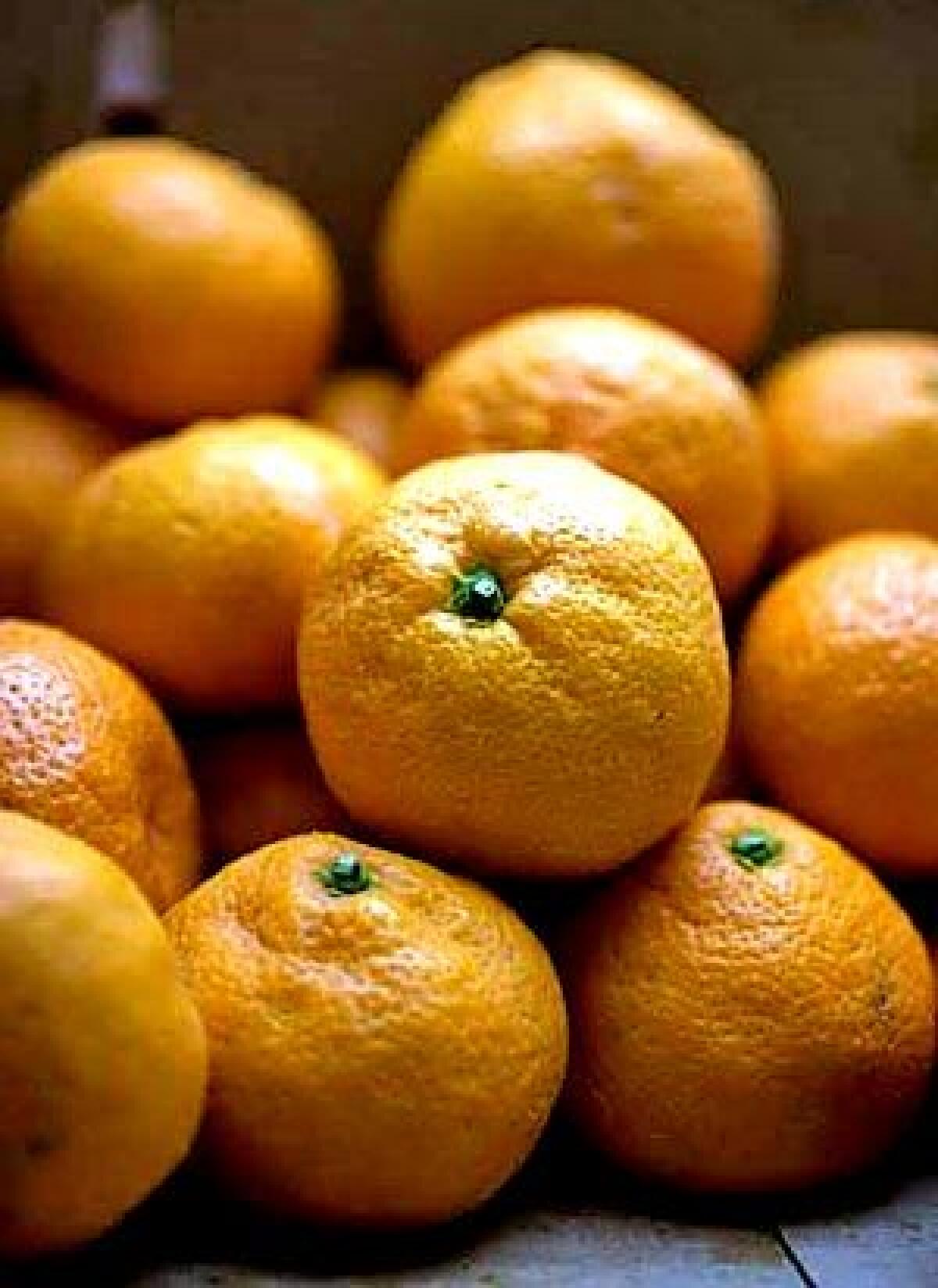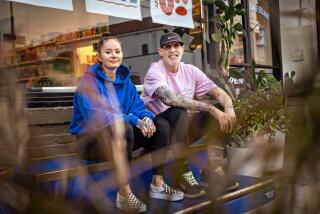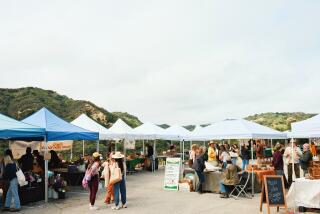Napa’s Oxbow Public Market redefines shopping

You say you want to know more about where your food comes from and how it is prepared? At Napa’s new Oxbow Public Market that opens this weekend, the butcher and the baker will do their work behind windows that will allow you to observe almost every step of the preparation. And the wine will be fermented in barrels you can reach out and touch.
The brainchild of Steve Carlin, who started his career by building the pioneering chain of upscale food markets Oakville Grocery and then supervised the development of the wildly popular Ferry Building Marketplace in San Francisco, the Oxbow market aims to do nothing less than redefine fine food shopping in the United States.
Along the way, Carlin hopes to change the lives of the artisans who create the foods, and even the town of Napa itself. And maybe someday in the not-too-distant future, bring the concept to a city near you.
Big dreams, to be sure. But take a walk with Carlin around the stunning modern building and you begin to think he might actually be able to pull it off.
Consider some of the folks he’s gotten involved. The butcher shop will be run by the Bay Area charcuterie stars of the Fatted Calf. The bread baking will be done by St. Helena’s beloved Model Bakery. And the winery will be run by Michael Mondavi.
Though construction will be completed this week and about half of the tenants will be open, it will be early spring before the market is fully operational.
The $11-million structure rises on the banks of the Napa River, looking like some postmodern barn, all metal roof and struts and light-filled inside. Along one exterior wall are 10 small (12- by 6-foot) “farm stands” that will be occupied by local growers on both long-term and short-term leases -- like a seven-day-a-week farmers market with a rotating cast of characters.
The interior of the main building is divided into 18 stalls, each from 250 to 400 square feet. This is where you’ll find Mondavi’s Folio Enoteca and Winery, which will initially sell only wines made locally and eventually only wines made at the market, as well as the Olive Press of Sonoma, which will offer six locally produced oils you can tap from giant metal cans, just like in Italy.
There will be Five Dot Ranch’s sustainably raised California beef; the Oxbow Cheese Shop, run by Kate Arding, who helped start Cowgirl Creamery; Whole Spice, a direct importer of dried herbs and spices; and Tillerman Tea, which finds and imports its own specialty teas. Carlin is negotiating a lease with a fishmonger, who will specialize in locally caught seafood.
There will also be a rotisserie cooker, a Venezuelan arepa stand, a bookstore, a culinary antiques collection, a store selling plates and linens, a separate, general wine shop, and an ice cream shop. A restaurant, a coffee bar and an oyster bar are still under negotiation.
In separate buildings adjacent to the main market will be the Fatted Calf’s full-service butcher shop, Model Bakery and a third outlet of St. Helena’s ever-popular hamburger stand Taylor’s Automatic Refresher.
The farmers market stands will be rented not just to professional farmers, but also to locals who might grow fruit or vegetables in their backyards. “Maybe he’s got excess Meyer lemons one day out of the year, we’ll try to work him in,” says Carlin. “I see kids coming down here and selling stuff from their parents’ gardens. It’s just one more way to build community.”
At one time, this kind of public market set-up was the norm, but most were driven out of business by the growth of supermarkets. Today, the few that survive are again thriving, treasured by the communities they serve.
The goal, Carlin says, is building another great market -- along the lines of the Ferry Building, Seattle’s Pike Place and Vancouver’s Granville Island -- but on a more compact scale that is more easily replicable.
“There have been lots of questions about whether a developer could start a real public market,” Carlin says. “Usually these kinds of places just develop on their own. But the thing that will make this work is that we’ve never varied from the concept of sticking with artisanal producers, people who always put the product first.”
One of those is the Fatted Calf, which until now has been operating at the extreme low economic end of the artisanal scale. Though its charcuterie products are considered among the best in the nation, it’s been making them at a leased kitchen in San Francisco and selling them mostly out of the back of a truck at three Bay Area farmers markets.
Taylor Boetticher, who owns the business with his wife, Toponia Miller, and partner Chuck Traugott, says that not only are they moving all of their production facilities to the Oxbow market and opening a retail outlet there, but they’ve moved their families to the area as well.
“This is a really big step for us,” he says, “probably the biggest we’re ever going to take. But when we talked to Steve, the whole market really seemed like a good idea. We really like the whole philosophy he used in putting the tenants together.
“And being part of a big marketplace is really appealing, especially since we know so many of the other people going in. They’re a lot of small local companies just like us. It’s not like he’s building some strip mall where there’s nothing but satellite versions of big chains going in.”
Carlin is a fountain of big ideas, and he has gotten to use most of them in building the Oxbow Public Market. From moment to moment he can shift from hard-core food fan carrying on about the finer points of his favorite artisanal producers, to urban planner talking about how the specific streetscape of his favorite corner in Berkeley influences the retail environment.
Then he puts on his marketer hat and discusses the tricky art of achieving the perfect balance of tenants, of prepared food and ingredient offerings, and of tourists and locals for customers. Interspersed might be an in-depth discussion of the building of flood walls and high-tech construction.
Carlin’s expertise is hard-won. His career in food started in 1980 when he took a job building the wine department at Joseph Phelps’ new Oakville Grocery in the heart of Napa Valley. When he left the company 20 years later, he was half-owner of a five-store chain that was grossing $20 million a year.
After taking a year off to live in Tuscany, he became project manager for San Francisco’s Ferry Building, and among his responsibilities was overseeing the start-up and development of the market, including the recruitment of the original tenants.
One of the things he learned along the way is how difficult the transition can be from creating an artisanal product to running a retail business. But he’s almost evangelical about its necessity.
“Right now, the way the system is set up, retailers and middlemen make all the money, and that’s what we’re trying to change,” Carlin says. “To do that, we have to work at teaching these producers a new trade and that is retail.
“One of the most important things we have to do is teach our merchants how to make money. These are all small-business men, and a lot of them don’t make much money yet. These are not your typical AAA credit tenants. But these are people who are fully committed to their products.”
And if these small producers can’t make enough money to stay in business, they’ll go away. The results, Carlin says, would be disastrous for us all.
“I really believe that if we don’t create a place for these producers and if we don’t help them create their brands, then those brands will go away and our food supply will be more and more homogenized and bland.”
There certainly is little danger of blandness at Oxbow. Boetticher has all sorts of meaty visions dancing in his head -- becoming a full-service butcher will allow him to deal more with individual ranchers who raise high-quality animals but prefer to deal in whole carcasses rather than just cryovac-ed, pre-portioned cuts.
This will let him do such things as offering whole suckling pigs already marinated and ready for roasting. And he’s also developing a line of house-made sauerkraut and pickles to accompany the sausages and pâtés.
That’s downright tame compared to another producer, Neal Gottlieb of Three Twins Organic Ice Cream. An eco-conscious guy, he’s putting in a human-powered milkshake maker (driven by pedaling a bicycle).
And he’s dreaming of a $3,333 ice cream sundae, made from reduced syrups of Château d’Yquem and vintage Port. Seemingly spontaneously, he begins talking about topping even that with a $60,000 sundae that will be made from the snow atop Mt. Kilimanjaro. “If you buy it, I’ll take you there myself and bring along a hand-cranked ice cream maker.”
Part of the excitement that is building around the market is due to the realization that it just could be the last missing piece in the puzzle that will turn around the town of Napa.
Until fairly recently, the city of Napa, which has a population of about 75,000, had been regarded as a blue-collar enclave almost totally separate from the wine country that shares its name. It was where the folks “up valley” came to buy tires but didn’t linger any longer than necessary.
That started to change five years ago with the opening of Copia, the “American Center for Wine, Food and the Arts,” largely funded by Robert Mondavi. But that project has never really seemed to find its footing and even now is in the midst of another reinvention.
Still, the area has all the earmarks of a great neighborhood for a market. Copia, which is still something of a draw with its wine and food education programs, is next door, sharing a parking lot. Across the street is the terminal for the Napa Valley Wine Train, and two new luxury hotel complexes -- a Ritz-Carlton and a Westin -- are being built within a five-minute walk.
Finally, Napa, which already boasts several very good restaurants in its historic downtown area, may have built the critical mass necessary to become part of the Napa Valley tourist circuit.
“Ten years from now, this whole area will be different,” Carlin says. “That’s what markets do in cities. They are magnets that draw people in.”
That said, Carlin makes it clear that Oxbow is not just another stop for culinary tourists -- a criticism that has sometimes been leveled at the Ferry Building. “To be a successful public market, you have to have a mix of locals and tourists,” Carlin says. “You need them both. But I’d say the long-term success of this market will depend on whether we can get support from the people of Napa.”
What works for Napa might well work for other cities too. Carlin is already planning a similar market in Santa Rosa and is in negotiations in Sacramento and San Jose as well as Portland, Ore., and Bellevue, Wash. And he’s exploring the possibilities in other areas, including Southern California.
“This market is not a business deal, it’s a business model,” Carlin says. “The way I see this market is that it’s a conduit between growers and customers and that’s something that will work in lots of different places.
“What Oxbow is about is creating markets in cities that already have an agricultural backdrop and that already have an artisanal food scene. What we want to do is pull all of those producers together with people who care about food and are willing to support them.
“I am positive that knowing where our food comes from is going to become much more important over the next few years. I’m convinced that the hardest challenge we face with these markets is not building demand, it’s building supply.
“We’re at the beginning of a movement, and the communities we’re talking to get that.”
More to Read
Sign up for our L.A. Times Plants newsletter
At the start of each month, get a roundup of upcoming plant-related activities and events in Southern California, along with links to tips and articles you may have missed.
You may occasionally receive promotional content from the Los Angeles Times.







